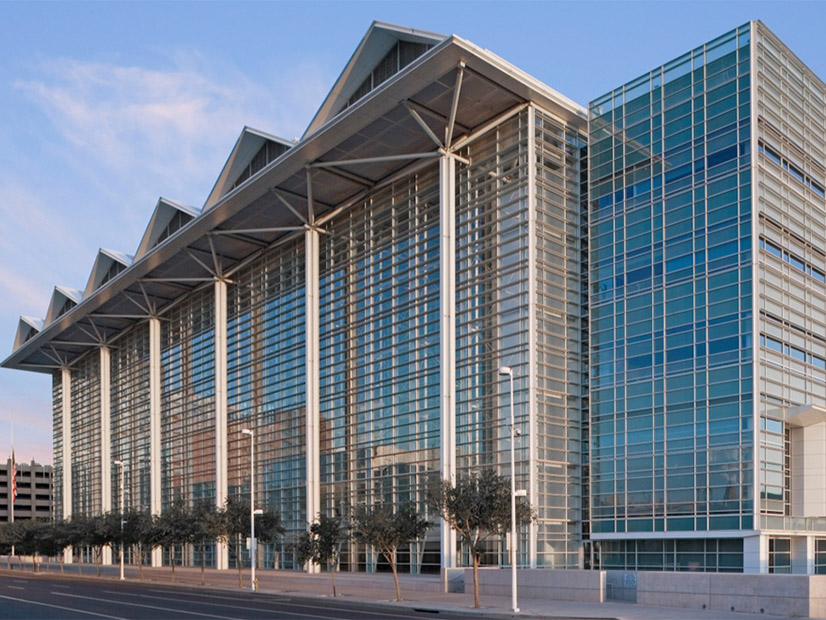
The General Services Administration (GSA) announced Nov. 6 that it will be spending just over $2 billion in funds from the Inflation Reduction Act (IRA) on low-carbon construction materials — concrete, glass, steel and asphalt — for repairs and upgrades on more than 150 federal buildings in 39 states, D.C. and Puerto Rico.
GSA Administrator Robin Carnahan rolled out the “Buy Clean” initiative in Topeka, Kan., where the Frank Carlson Federal Building and Courthouse will be getting a $25 million facelift with new windows and doors with blast-resistant aluminum frames and insulated low-embodied carbon (LEC) glass that will reduce the building’s energy use. Sidewalks and parking areas at the building will also be updated with LEC concrete.
Project design is to begin in fiscal 2024, with construction to follow in 2025, according to GSA.
Embodied carbon emissions are those generated by a material’s production, transportation, installation, use and disposal. LEC materials “have substantially lower levels of embodied greenhouse gas emissions,” according to a GSA fact sheet. The LEC concrete, glass, steel and asphalt used for the projects announced Nov. 6 could cut the federal buildings’ greenhouse gas emissions by 41,000 metric tons and create 6,000 jobs per year for the life of the projects, a GSA press release said.
“By incorporating clean construction materials in more than 150 projects across the country, we’re helping create … the clean manufacturing industries of the future and sending a clear signal that the homegrown market for these sustainable products is here to stay,” Carnahan said in the press release.
Federal demand for LEC construction materials is potentially huge. GSA manages more than 9,600 federal buildings, covering a total of 375 million square feet, in 2,000 communities across the country, according to the administration’s website. The government’s building stock ranges from courthouses, Internal Revenue Service offices, border stations and warehouses, to data centers and laboratories.
According to GSA, the IRA provided the administration with $3.375 billion to invest in federal buildings to cut emissions and spur innovation by buying and installing LEC materials. The administration has focused on concrete, glass, steel and asphalt because they are all carbon-intensive materials that together generate close to half of all GHG emissions from U.S. manufacturing.
They also account for 98% of the construction materials the government either pays for or funds for federal infrastructure projects, GSA said.
The price tag for the current round of projects includes $384 million for asphalt, $767 million for concrete, $464 million for glass and $388 million for steel.
Senate Majority Leader Chuck Schumer (D-N.Y.) praised GSA for getting the IRA dollars “out the door.”
“This funding helps create a market for low- and zero-carbon materials, further incentivizing industrial manufacturers to take advantage of other IRA programs aimed at helping them reduce their emissions,” Schumer said. “This ecosystem of incentives approach is part of what makes the IRA so impactful and resilient.”
What is ‘Substantially Lower’?
The Buy Clean initiative was launched to support President Joe Biden’s Federal Sustainability Plan, rolled out in December 2021. The plan set a 2045 target for federal buildings to cut GHG emissions to net zero, with an interim goal of 50% by 2032 and a 2050 deadline for net-zero federal procurements.
GSA collaborated with the Department of Transportation and EPA to develop a set of “interim determinations” for designating materials like asphalt, glass, concrete and steel as low carbon. The guidelines are being tested out on 11 projects during a pilot period that began in May.
A core issue was defining the “substantially lower” emissions required for LEC materials to qualify for IRA funding. EPA defined the term “as meaning a global-warming potential that is in the best-performing 20% … when compared to similar materials/products,” according to a December 2022 letter to GSA from EPA Deputy Administrator Janet McCabe.
If materials cannot be found that meet that “Top 20%” limit, EPA then set a second level of best-performing 40%, and a third level of “better than the estimated industry average,” both of which could still qualify for IRA funding.
EPA also is “working with the construction materials manufacturing industry and [nongovernmental organizations] to help track the climate impacts of their operations and to develop a labeling program that will clearly identify lower carbon construction materials in the marketplace,” McCabe said in the GSA press release.
According to the GSA fact sheet, the administration is continuing work on the 11 pilot projects and reports that “progress is being made to source LEC materials on these projects.”
More awards could be coming in the first half of 2024, the fact sheet says, but GSA decided to announce the current round of projects “to inform the market of the breadth of our plan, and to help position U.S. manufacturers, suppliers and installers to capitalize on this exciting opportunity.”

